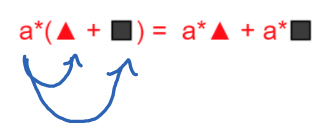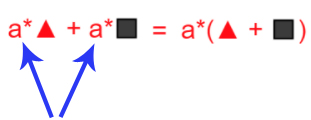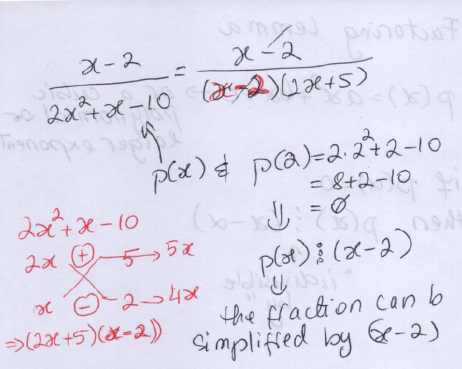Academix
A Non-profit Organization to Help Students Study, Explore, and Engage
Polynomials and Factoring (grade 10)

Polynomials |
|
| Lessons | http://tutorial.math.lamar.edu/Classes/Alg/Polynomials.aspx |
| Polynomial Functions | http://carlisleschools.ss13.sharpschool.com/cms/One.aspx?portalId=95563&pageId=768777 |
| What is the difference between algebraic and arithmetic fractions? | https://www.math-only-math.com/arithmetic-fraction-and-algebraic-fraction.html |
Polynomials, Factoring
|
|
|
Before you begin working on this
concept: Part I |
How do brackets work?Brackets are an important concept to factorization. Practice extracting simple factors out in front of brackets.Example First, a factor distributes to all elements in the brackets when expanding the expression.  Learn to recognize this in reverse:  “a” is multiplied in both expressions. Recognize it as a factor that can play its role in front of brackets. Practice creating brackets from simple expressions. Click here if you have difficulty with this part... |
|
Before you begin working on this
concept: Part II |
Recognizing the
major algebraic formulas in reverse is very useful in factorizing polynomials as it gives immediate results.
For example: a2 - b2 should be immediately recognized in its factorized form simply based on the formula (a+b)(a-b) Or for example should always be recognized as |
 Example: The Factoring Lemma is useful when we want to simplify a rational polynomial quickly. For the following fraction to simplify we would need (x-2) to divide the denominator. No other than (x-2) would be interesting here since this is the only thing in the numerator. A quick check of p(2) shows = 0 and it thus becomes clear the denominator is divisible by (x-2). This knowledge helps factorize the denominator faster.  |
|
| Polynomials, Factoring slide show |
|
| Factoring Methods | |
| Factoring Methods, Advanced | http://www.shelovesmath.com/algebra/advanced-algebra/advanced-factoring/ |
| What is Factorizing Polynomials? |
More on Factorizing Polynomials here. |
| Divisibility of numbers is a useful concept for factoring polynomials: |
Quick ways to determine divisibility: A number is divisible by 2 if it terminates with 2, 4, 6, 8, or 0. A number is divisible by 3 if the sum of its digits is divisible by 3. A number is divisible by 4 if the last two digits are divisible by 4. A number is divisible by 5 if it terminates with 5 or 0. A number is divisible by 6 if it is divisible by both 2 and 3. A number is divisible by 8 if the last three digits are divisible by 8. A number is divisible by 9 if the sum of digits is divisible by 9. A number is divisible by 10 if it terminates with 0. |
| Worksheet 2.6 Factorizing
Algebraic Expressions (PDF Download) |
 |
|
Lectures and Practice |
https://www.khanacademy.org/math/algebra/polynomial-factorization |
| Factoring Trinomials Tips and Tricks | |
| Practice and solutions | http://tutorial.math.lamar.edu/Classes/Alg/Factoring.aspx |
| Art of Problem Solving: Simon's Favorite Factoring Trick | |
| Criss Cross Method (why does it work?) |
|
| Factoring Trinomials |
|
| Dividing Polynomials |
|
| Polynomials, Synthetic Division |
|
| Various
Calculators on Wolfram |
https://www.wolframalpha.com/examples/mathematics/algebra/
|
| Factoring
Calculator on Wolfram https://www.wolframalpha.com/input/?i=6x%5E2+-+x+-+2 |
 |
|
This page is sponsored by Sharp Book Series  |
|
Academix: Study, Explore, Engage...
Copyright © 2025 Academix. All Rights Reserved.